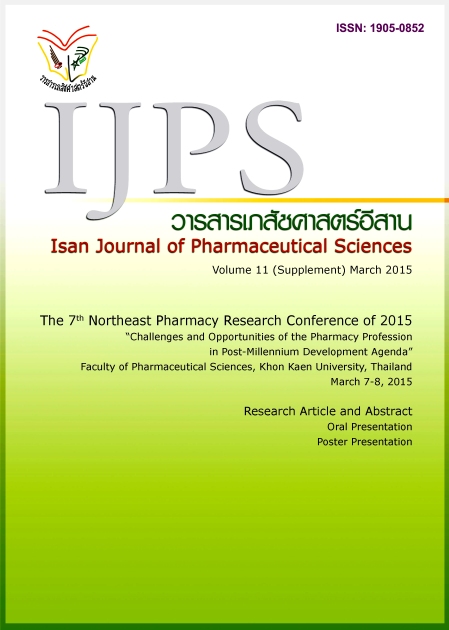Relationship between formulation factors and physicochemical characteristics of microemulsions by response surface method
Main Article Content
Abstract
Introduction: Generally, the development of microemulsions (MEs) is based on trial and error methods. To obtain the appropriate MEs for transdermal drug delivery with simultaneously desirable physicochemical characteristics including high skin permeation, high stability and high safety. Therefore an optimization process based on computer program is an alternative method to apply in the development of MEs. Materials and Method: The model MEs were prepared according to the ME region obtained from the pseudo-ternary phase diagram. Using simplex lattice design as a model experimental design, the MEs were experimentally formulated and investigated. The ME systems were formulated with oleic acid, Cremophor® RH40, ethanol, water and meloxicam, and their physicochemical characteristics (e.g., droplet size, charge, conductivity, pH, drug loading capacity) and skin permeation flux were evaluated. The ME’s compositions and the physicochemical characteristics were defined as formulation factors (Xn) and response variables (Yn), respectively. The relationship between formulation factor and physicochemical characteristics was investigated using Design Expert® program. Results: The response surfaces estimated by Design Expert® program exhibited obvious relationship between formulation factor and physicochemical characteristics. The formulation factor directly affected the physicochemical characteristics of MEs. The complicated relationship between formulation factor and physicochemical characteristics was clarified using the response surface method. Conclusion: The response surface method was beneficial for the development of MEs for transdermal drug delivery. Using the response surfaces, the physicochemical characteristics of MEs can be predicted without experimentally formulated and characterization.
Article Details
In the case that some parts are used by others The author must Confirm that obtaining permission to use some of the original authors. And must attach evidence That the permission has been included
References
Baroli B, López-Quintela MA, Delgado-Charro MB, Fadda AM, Blanco-Méndez J. Microemulsions for topical delivery of 8-methoxsalen. J Control Release 2000; 69: 209-218.
Duangjit S, Mehr LM, Kumpugdee-Vullrath M, Ngawhirunpat T. Role of simplex lattice statistical design in the formulation and optimization of microemulsions for transdemal delivery. Biol Pharm Bull 2014; 37(12): 1948-1957.
Duangjit S, Obata Y, Sano H, Onuki Y, Opanasopit P, Ngawhirunpat T, et al. Comparative Study of Novel Ultra deformable Liposomes: Menthosomes, Transfersomes and Liposomes for Enhancing Skin Permeation of Meloxicam. Biol Pharm Bull 2014;37(2):239–247.
Duangjit S, Opanasopit P, Rojanarata T, Ngawhirunpat T. Characterization and in vitro skin permeation of meloxicam-loaded liposomes versus transfersomre. J Drug Deliv 2010;2012, Article ID 418316, 9 pages, doi:10.1155/2011/418316.
Lee PJ, Langer R, Shatri VP. Novel microemulsion enhancer formulation for simultaneous transdermal delivery of hydrophilic and hydrophobic drugs. Pharm Res 2003;20(2):264-269.
Mei Z, Chen H, Weng T, Yang Y, Yang X. Solid lipid nanoparticle and micro emulsion for topical delivery of triptolide. Eur J Pharm Biopharm 2003 9//;56(2):189-196.
Ngawhirunpat T, Opanasopit P, Rojanarata T, Akkaramongkolporn P, Ruktanonchai U, Supahol P. Development of Meloxicam-Loaded Electrospun Polyvinyl Alcohol Mats as a Transdermal Therapeutic Agent. Pharm Dev Tech 2009; 14:70-79.
Ngawhirunpat T, Panomsuk S, Opanasopit P, Rojanarata T, Hatanaka T. Comparison of the percutaneous absorption of hydrophilic and lipophilic compounds in shed snake skin and human skin. Pharmazie 2006; 61: 331-336.
Ngawhirunpat T, Worachun N, Opanasopit P, Rojanarata T, Panomsuk S. Cremophor RH40-PEG 400 microemulsions as transdermal drug delivery carrier for ketoprofen. Pharm Dev Technol 2013; 18(4): 798-803.
Pappinen S, Urtti A. Microemulsions in topical drug delivery. In: Smith EW, Maibach HI, editors. Percutaneous penetration enhancers. New York: CRC Press; 2006. p. 109-116.
Peltola S, Saarinen-Savolainen P, Kiesvaara J, Suhonen TM, Urtti A. Microemulsions for topical delivery of estradiol. Int J Pharm 2003 3/26/; 254(2): 99-107.
Seedher N, Bhatia S. Mechanism of interaction of the non-steroidal antiinflammatory drugs meloxicam and nimesulide with serum albumin. J Pharm Biomed Analysis 2005; 39: 257-262.
Williams AC. Transdermal and topical drug delivery. London: Pharmaceutical Press; 2003.

